ORGANIZATION
12-24. The law and order element consists of a chief, a police intelligence warrant officer, a senior military customs inspector noncommissioned officer, a military working dog program noncommissioned officer, and a police intelligence noncommissioned officer.
TASKS
12-25. The law and order element plans, coordinates, facilitates, and provides staff supervision for the execution of law and order operations throughout the AO. Law and order operations consist of policing and law enforcement, criminal investigations, traffic operations, host nation police support, customs, police engagement, special reaction teams, and police intelligence operations. The law and order element coordinates support for patrol, military working dog, counterdrug, customs, high-risk personnel security, and protective service operations. During civil support operations, it provides staff support to federal agencies for civil disturbances, immigration emergencies, and law and order operations for the AO. The element provides theater law enforcement and criminal investigation data management for the AO. The element manages the crime prevention program for the AO. It manages military working dogs employed by U.S. and contract security in the AO. It conducts joint, interagency, intergovernmental and multinational police coordination and liaison.
AIR AND MISSILE DEFENSE SECTION
12-26. Paragraphs 12-27 through 12-29 discuss the mission, organization, and tasks of the air and missile defense section.
MISSION
12-27. The air and missile defense section develops plans and policy for air and missile defense synchronization in support of the theater army AO.
ORGANIZATION
12-28. The air and missile defense section consists of a chief, one operations officer, and a noncommissioned officer.
TASKS
12-29. The air and missile defense section coordinates operational-level air and missile defense with theater air and missile defense representatives, and other Service headquarters, while serving as the primary operational and planning link between the combatant commander, the theater army, and Headquarters, Department of the Army for air and missile defense related issues and policies. The section develops air and missile defense input to support theater army estimates, plans, and orders. It produces and maintains air and missile defense designs based on recommended air and missile defense priorities. It assists airspace management and fires planners, as required. The section gathers intelligence, maneuver, and logistical graphics and control measures products to support air and missile defense planning. The section plans, integrates, and synchronizes apportioned air and missile defense assets with maneuver requirements.
12-4
FM 3-93
12 October 2011
Theater Army Protection Cell
CHEMICAL, BIOLOGICAL, RADIOLOGICAL, AND NUCLEAR
SECTION
12-30. Paragraphs 12-31 through 12-33 discuss the mission, organization, and tasks of the chemical, biological, radiological, and nuclear (CBRN) section.
MISSION
12-31. The CBRN section develops a comprehensive program focused on all aspects of CBRN and weapons of mass destruction within the AOR. It develops policy and plans to support the National Military Strategy to combat weapons of mass destruction at theater level.
ORGANIZATION
12-32. The CBRN section consists of a chief and one senior explosive ordinance disposal noncommissioned officer.
TASKS
12-33. The CBRN section provides contingency planning, analysis, coordination, and staff supervision across the AO for CBRN operations. The section plans and monitors support for consequence management operations. It provides input for CBRN force management and time-phased force and deployment data processes. The section coordinates and integrates CBRN support with external organizations such as the Defense Threat Reduction Agency and the United States Army Nuclear and Combating Weapons of Mass Destruction Agency. It monitors weapons of mass destruction sensitive site exploration operations in the AOR. The section develops and refines plans covering toxic industrial materials and proper protocols and procedures to mitigate and remove hazards. It develops estimates, plans, and orders to coordinate CBRN
defense measures and provides warning and reporting. It synchronizes the use of obscurants in the AOR. It develops plans and policies for explosive ordinance disposal in the AO. The section maintains the theater reserve of CBRN equipment and monitors AOR weapons of mass destruction and arms control activities.
OPERATIONAL SECURITY SECTION
12-34. Paragraphs 12-35 through 12-37 discuss the mission, organization, and tasks of the operational security section.
MISSION
12-35. The operational security section plans, coordinates, integrates, synchronizes, reviews, and refines operational security policies for the AO.
ORGANIZATION
12-36. The operational security section consists of an operational security officer.
TASKS
12-37. The operational security section organizes and manages the operational security program to include oversight of subordinate programs. It recommends critical information lists and essential elements of friendly information to the commander. The section publishes a standard operating procedure with critical information lists, essential elements of friendly information, and appropriate operational security measures. The section conducts operational security reviews of documents, interviews, contracts, DD Form 254 (Department of Defense Contract Security Classification Specification), Web sites, and any other material that discusses work related information prior to release for public distribution.
12 October 2011
FM 3-93
12-5
Chapter 12
PERSONNEL RECOVERY SECTION
12-38. Paragraphs 12-39 through 12-41 discuss the mission, organization, and tasks of the personnel recovery section.
MISSION
12-39. The personnel recovery section integrates personnel recovery guidance into mission planning and accomplishing Title 10 personnel recovery responsibilities.
ORGANIZATION
12-40. The personnel recovery section consists of an aviation officer and one warrant officer.
TASKS
12-41. The personnel recovery section plans, coordinates, synchronizes, monitors, and manages personnel recovery missions in the AO. It integrates data from the intelligence warfighting functional cell to continually refine and update personnel recovery efforts. The section monitors, tracks, and reports on subordinate organizations’ personnel recovery operations. The section reviews and updates personnel recovery programs and standard operating procedures. The section oversees the isolated personnel report program. The section manages personnel recovery training, doctrine, and logistics for the theater. The section assists subordinate commands in the development of their personnel recovery programs.
SAFETY SECTION
12-42. Paragraphs 12-43 through 12-45 discuss the mission, organization, and tasks of the safety section.
MISSION
12-43. The safety section provides strategic safety planning and composite risk management oversight for the theater army.
ORGANIZATION
12-44. The safety section consists of a chief, one safety officer, and one aviation safety warrant officer.
The section chief is part of the theater army commander’s personal staff.
TASKS
12-45. The safety section reviews orders, operations, and exercises to ensure that composite risk management is incorporated. It conducts safety reviews and refines safety plans and orders for implementation. The section conducts safety program evaluations, and it conducts accident investigation as necessary. The section reviews lessons learned, as well as accidents and incidents from subordinate units, to update safety policies and programs. The section provides and coordinates accident investigation and reporting for the following: explosives safety management, contracting, chemical, radiation, system, industrial, range, marine, and port safety. It also coordinates accident investigation and reporting for marine activities, safe cargo operations, emergency planning and response, workplace inspections, training, and tactical safety.
12-6
FM 3-93
12 October 2011
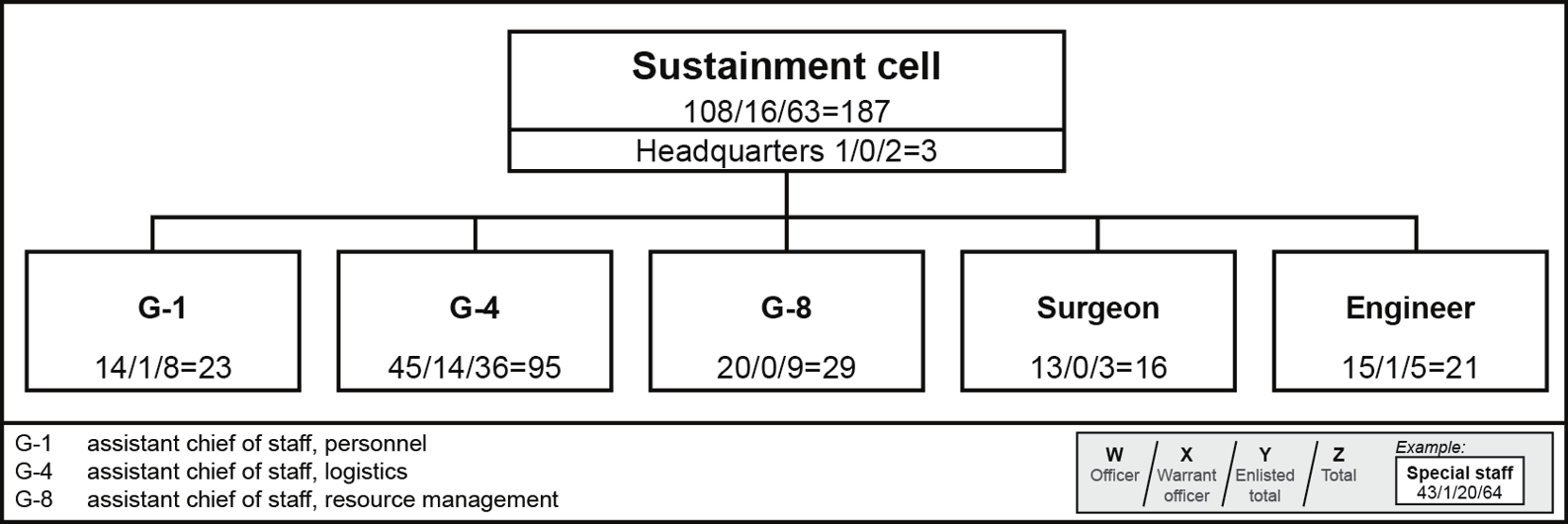
Chapter 13
Theater Army Sustainment Cell
13-1. The theater army sustainment cell integrates the diverse and separate functions of the assistant chief of staff, personnel (G-1), assistant chief of staff, resource management (G-8), assistant chief of staff, logistics (G-4), surgeon, and engineer sections, including the common tasks and systems (people, organizations, information, and processes) that commanders use to accomplish missions and training objectives. It involves many of the technical specialties and activities enumerated under the Army universal task list tactical task 4.0 categories of maintenance, supply, field services, and some transportation tasks, as well as human resource support, financial management, Army health support, engineering facilities construction, and internment and resettlement. (See FM 7-15 for more information on Army tactical tasks.) The theater army is responsible for planning and providing a wide range of functions and services, including Title 10, Army support to other Services (ASOS), and Army executive agent. Figure 13-1 depicts the theater army 5.4 sustainment cell. (This organization is in accordance with design, not the modified table of organization and equipment or the Table of Distribution and Allowance.) The supported force may be joint, interagency, intergovernmental, or multinational. The theater army provides support to contractors, civilians (including dislocated citizens and disaster victims), or members of nongovernmental organizations if required. Theater enabling units plan and execute the delivery of these services, in most cases. The theater army sustainment cell consists of a headquarters, a G-1 section, a G-4 section, a G-8 section, surgeon section and an engineer section.
Figure 13-1. Theater army 5.4 sustainment cell
SUSTAINMENT CELL HEADQUARTERS ELEMENT
13-2. Paragraphs 13-3 through 13-5 discuss the mission, organization, and tasks of the sustainment cell headquarters element.
MISSION
13-3. The sustainment cell headquarters element manages and synchronizes sustainment operations for the theater army commander.
ORGANIZATION
13-4. The sustainment cell headquarters section consists of the sustainment chief, the noncommissioned officer in charge, and a driver.
12 October 2011
FM 3-93
13-1
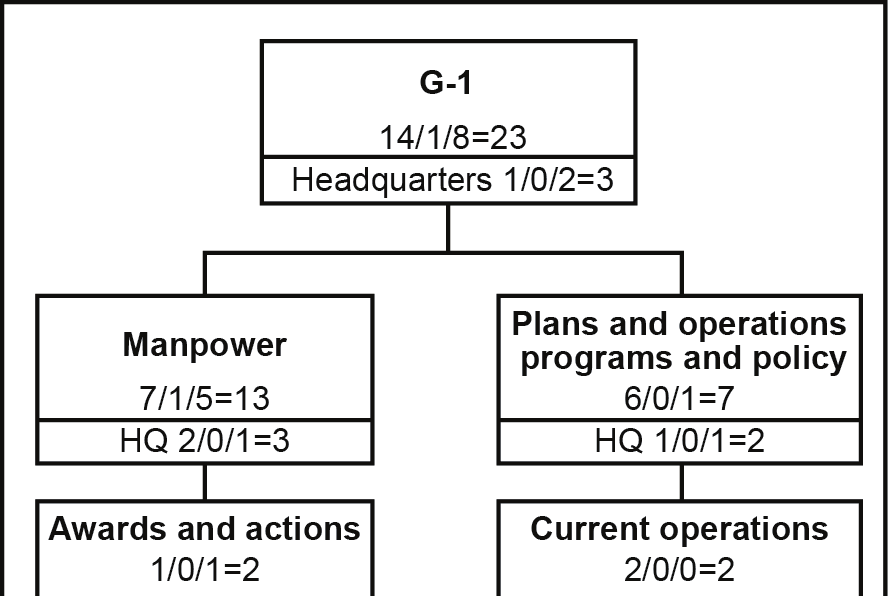
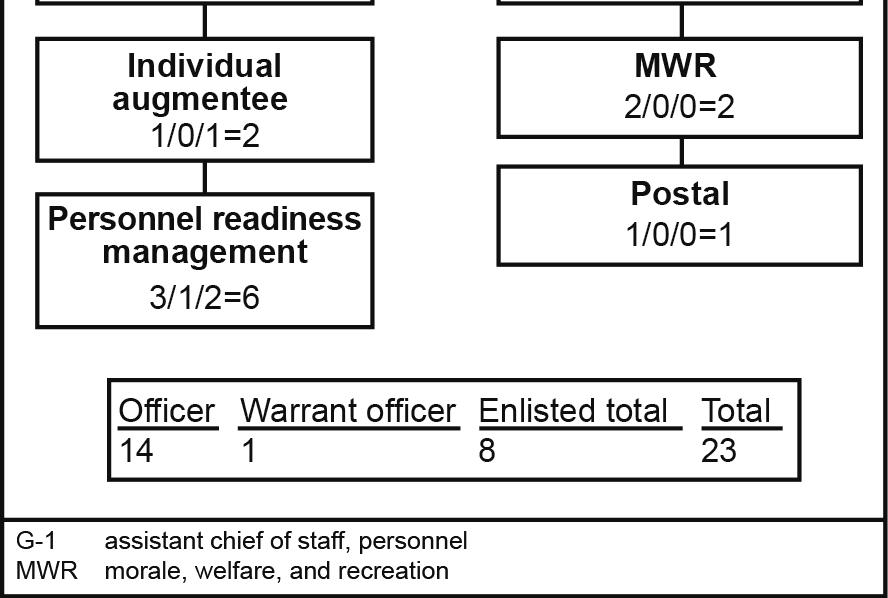
Chapter 13
TASKS
13-5. The element determines and prioritizes requirements, allocates resources, and provides information and recommendation to the commander for sustainment.
G-1 DIVISION AND HEADQUARTERS SECTION
13-6. Paragraphs 13-7 through 13-9 discuss the mission, organization, and tasks of the G-1 division and headquarters section.
MISSION
13-7. The G-1 division and headquarters section ensures the readiness and operational capabilities of forces by properly planning, prioritizing, coordinating, integrating, and managing theater army and joint level human resource support. Figure 13-2 depicts the theater army 5.4 G-1. (This organization is in accordance with design, not the modified table of organization and equipment or the Table of Distribution and Allowance.)
Figure 13-2. Theater army 5.4 G-1
ORGANIZATION
13-8. The G-1 division and headquarters section consists of the manpower section and a plans, operations, programs, and policy section. The G-1 headquarters element consists of the section chief, a human resources sergeant major, and a junior noncommissioned officer.
TASKS
13-9. The G-1 division and headquarters section develops and promulgates human resources policy, plans, priorities, and procedures for the theater. A few examples are casualty and postal operations, strength reporting, and the rest and recuperation and the morale, welfare, and recreation programs. The section provides operational oversight of human resource support and training programs.
13-2
FM 3-93
12 October 2011
Theater Army Sustainment Cell
MANPOWER SECTION AND HEADQUARTERS ELEMENT
13-10. Paragraphs 13-11 through 13-13 discuss the mission, organization, and tasks of the manpower section and headquarters element.
MISSION
13-11. The manpower section establishes policy for and manages the theater army awards and personnel readiness programs for the area of responsibility (AOR).
ORGANIZATION
13-12. The manpower section is comprised of a headquarters element and an awards and actions element, an individual augmentation element, and a personnel readiness management element. The headquarters element has a section chief, a strength accounting officer, and a senior human resources noncommissioned officer in charge.
TASKS
13-13. The manpower section establishes, manages, and executes theater army awards and decorations programs. It monitors and reports personnel readiness of units within the AOR. It manages personnel readiness of the theater army headquarters, which includes personnel augmentation. The section conducts unit readiness and personnel distribution analysis, distributes casualty and replacement plans, and manages the rotation policy. It assists in reconstitution and reorganization efforts and monitors theater casualties. In conjunction with the human resources sustainment center, it conducts theater-level strength reporting analysis, and establishes and monitors the theater army deployed personnel database.
AWARDS AND ACTIONS ELEMENT
13-14. Paragraphs 13-15 through 13-17 discuss the mission, organization, and tasks of the awards and actions element.
MISSION
13-15. The awards and actions element establishes and manages the theater army’s awards program.
ORGANIZATION
13-16. The awards and actions element is comprised of a personnel officer and a human resources noncommissioned officer.
TASKS
13-17. The awards and actions element supports the G-1 in building, generating, coordinating, and sustaining Army and joint awards and personnel actions programs, policies, and procedures. It provides regulatory guidance on awards and personnel actions in coordination with subordinate commands. The element coordinates and monitors actions forwarded to the Department of the Army for approval. The element coordinates congressional actions and line of duty investigations.
INDIVIDUAL AUGMENTEE MANAGEMENT ELEMENT
13-18. Paragraphs 13-19 through 13-21 discuss the mission, organization, and tasks of the individual augmentee element.
12 October 2011
FM 3-93
13-3
Chapter 13
MISSION
13-19. The individual augmentee element establishes policy and manages the individual augmentee process for the theater army.
ORGANIZATION
13-20. The individual augmentee management element is comprised of one officer and one noncommissioned officer.
TASKS
13-21. The individual augmentee element coordinates and manages individual augmentation for theater forces. It reviews, analyzes, and processes manpower requests for active component, Army National Guard, United States Army Reserve, and retiree recalls filling wartime individual augmentation system positions.
The element coordinates with the Headquarters, Department of the Army Human Resources Command and commands on the deployment process and priorities for personnel placement in contingency operations based on priorities of fill. It assists and manages personnel actions to include extensions and renewal of position requirements.
PERSONNEL READINESS MANAGEMENT ELEMENT
13-22. Paragraphs 13-23 through 13-25 discuss the mission, organization, and tasks of the personnel readiness management element.
MISSION
13-23. The personnel readiness management element manages personnel readiness for theater army forces in the AOR.
ORGANIZATION
13-24. The personnel readiness management element consists of an element chief, a strength accounting officer, a readiness officer, a military personnel warrant officer, and two senior human resources noncommissioned officers.
TASKS
13-25. The element assists the operations element and headquarters section in building, generating, coordinating, and sustaining theater army officer and enlisted management programs, systems, policies, and procedures. The element manages readiness, replacement, and accountability of officers and enlisted personnel. It manages strength reporting, reconstitutes forces, and receives subordinate joint personnel status and casualty reports. It analyzes, compiles, and submits joint personnel status and casualty reports.
The element assists in unit status reporting. It downloads, reviews, and publishes results of promotion lists, and it processes strength related personnel actions.
PLANS AND OPERATIONS PROGRAMS AND POLICY SECTION
AND HEADQUARTERS ELEMENT
13-26. Paragraphs 13-27 through 13-29 discuss the mission, organization, and tasks of the plans and operations programs and policy section and headquarters element.
MISSION
13-27. The plans and operations programs, policy section provides the theater army with current operations support, planning, morale, welfare, and recreation (MWR) and postal support.
13-4
FM 3-93
12 October 2011
Theater Army Sustainment Cell
ORGANIZATION
13-28. The plans, operations, programs and policy section consists of four elements. They are headquarters, current operations, MWR, and postal. The headquarters element consists of a section chief and a senior human resources noncommissioned officer.
TASKS
13-29. The plans, operations, programs and policy section facilitates the tracking and management of human resources operations in the AOR. It maintains a G-1 common operating picture. It provides human resources representation for theater army planning and exercises. It develops and coordinates future human resources plans and operations. The section, in coordination with the human resources sustainment center, participates in joint operational planning. It conducts casualty operations and replacement policies and planning. It develops rest and recuperation policy, synchronizes MWR activities, and provides oversight for casualty operations. The section manages and oversees theater postal operations including the development and integration of policies and procedures.
CURRENT OPERATIONS ELEMENT
13-30. Paragraphs 13-31 through 13-33 discuss the mission, organization, and tasks of the current operations element.
MISSION
13-31. The current operations element provides human resources coordination and oversight of current operations.
ORGANIZATION
13-32. The current operations element consists of two human resources officers.
TASKS
13-33. The current operations element, in coordination with the human resources sustainment center, executes human resources planning and operations. It provides policy guidance and staff supervision for human resources operations. It conducts analysis of human resource and casualty operations. It provides human resources input for estimates, plans, and orders. It integrates noncombatant evacuation into analysis and plans. The element supports the G-1 in building, generating, coordinating, and sustaining theater army and joint human resources plans and operations systems, policies, and procedures.
MORALE, WELFARE, AND RECREATION ELEMENT
13-34. Paragraphs 13-35 through 13-37 discuss the mission, organization, and tasks of the MWR element.
MISSION
13-35. The MWR element establishes policy, and it coordinates and manages MWR activities and services for the theater army.
ORGANIZATION
13-36. The MWR element consists of two human resources officers.
12 October 2011
FM 3-93
13-5
Chapter 13
TASKS
13-37. The MWR element establishes MWR policy. It coordinates and manages MWR activities and services for the theater army. It acquires host-nation support for MWR activities. It supports recreation and recuperation sites, locations, and activities. It coordinates with the Army and Air Force Exchange Service, the Red Cross, United Service Organizations, and Armed Forces Entertainment to develop and maintain wartime standards of service. The element manages unit MWR funds and the rest, recuperation, and MWR
trip programs. It also manages donations, United Service Organizations procedures, and policies governing operational deployments.
POSTAL ELEMENT
13-38. Paragraphs 13-39 through 13-41 discuss the mission, organization, and tasks of the postal element.
MISSION
13-39. The postal element establishes postal policies and manages postal operations for the theater army.
ORGANIZATION
13-40. The postal element has one postal officer.
TASKS
13-41. The postal element coordinates with the human resources sustainment center, the theater support command, and the Military Postal Service Agency for postal operations throughout the AOR. It develops and integrates postal policies and procedures for the AOR. It develops and coordinates contractual postal support operations.
G-4 SECTION AND HEADQUARTERS ELEMENT
13-42. Paragraphs 13-43 through 13-45 discuss the mission, organization, and tasks of the G-4 section and headquarters element.
MISSION
13-43. The G-4 section and headquarters element develops plans and policies, establishes priorities, integrates logistics, and assesses readiness. The sections inside the G-4 section do not manage commodities, but rather they establish policies, plans, and priorities for execution and synchronization by the theater sustainment command. Figure 13-3 depicts the theater army 5.4 G-4. (This organization is in accordance with design, not the modified table of organization and equipment or the Table of Distribution and Allowance.)
13-6
FM 3-93
12 October 2011
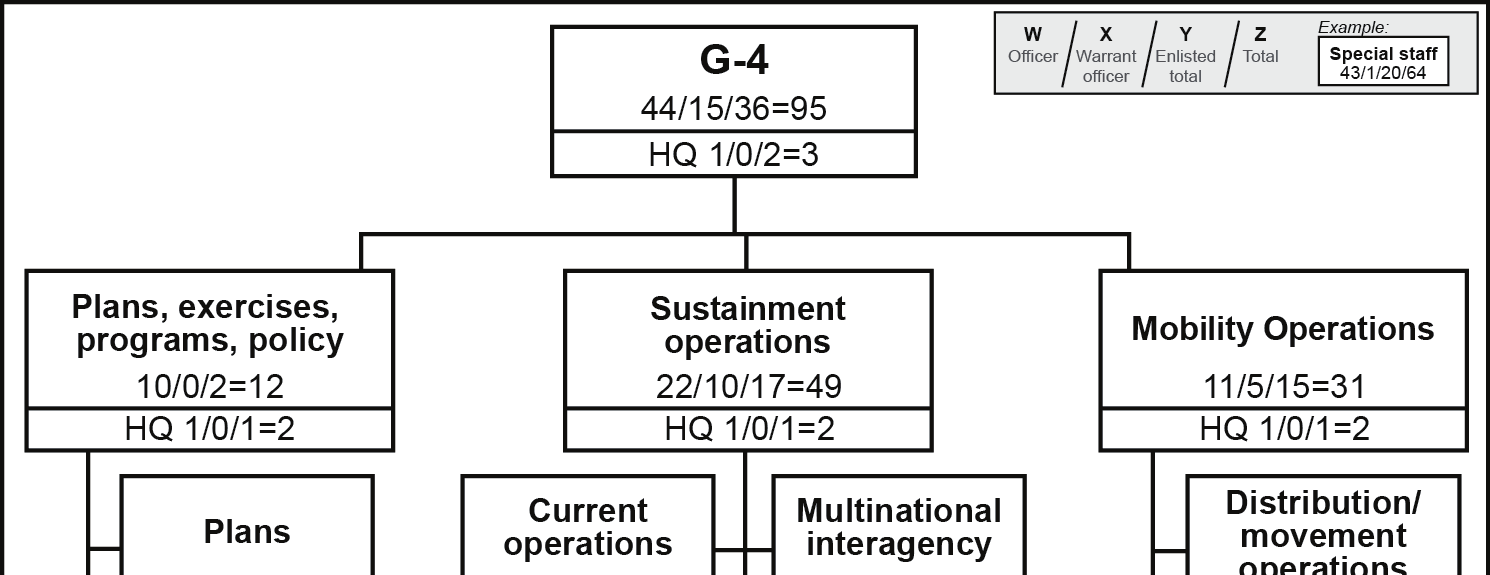
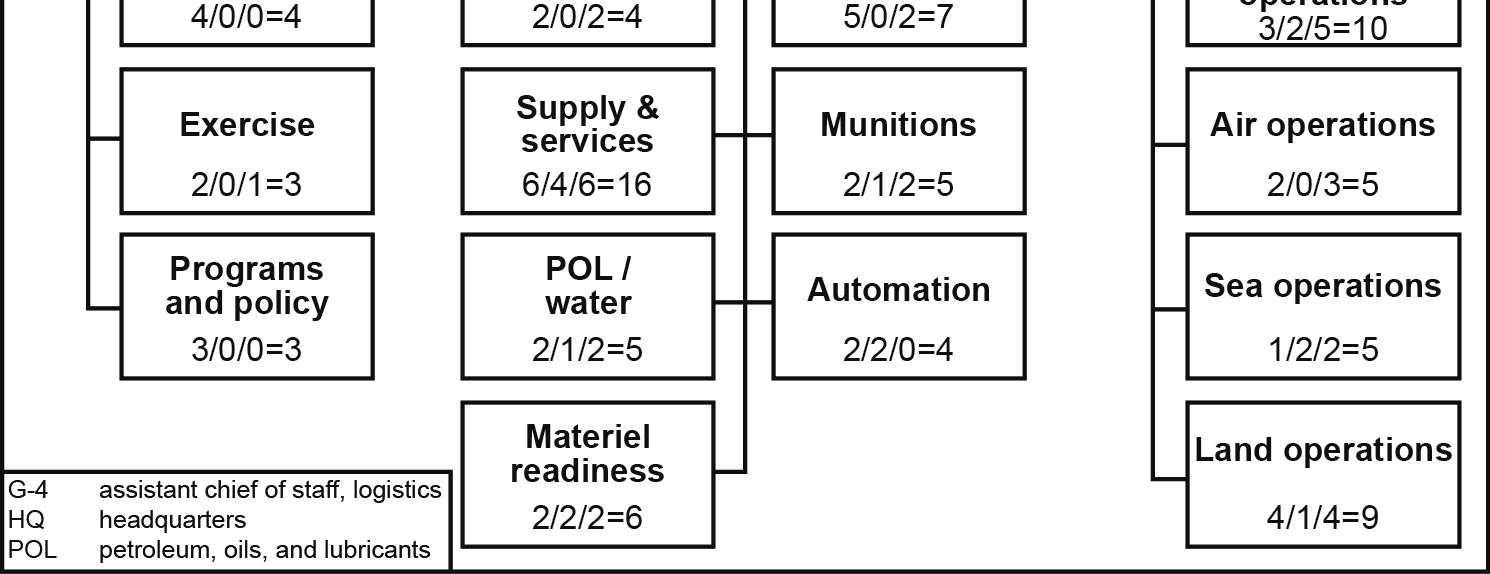
Theater Army Sustainment Cell
Figure 13-3. Theater army 5.4 G-4
ORGANIZATION
13-44. The G-4 section consists of a headquarters element and three sections: the plans, exercises, programs, and policy section, the sustainment operations section, and the mobility operations section. The headquarters section consists of the G-4, the senior logistics noncommissioned officer, and one supply noncommissioned officer.
TASKS
13-45. The primary function of the G-4 section and headquarters element is to assess, coordinate, integrate, direct, and provide all theater army and joint sustainment operations and programs. It provides planning, policy, and staff oversight of Title 10 and ASOS requirements in support of theater missions. It supports the contingency command post, when deployed.
PLANS, EXERCISES, PROGRAMS, AND POLICY SECTION AND
HEADQUARTERS ELEMENT
13-46. Paragraphs 13-47 through 13-49 discuss the mission, organization, and tasks of the plans, exercises, programs, and policy section and headquarters element.
MISSION
13-47. The plans, exercises, programs, and policy section and headquarters element prepares the concept of support for estimates, plans, and orders. It analyzes, evaluates and monitors the force flow inputs for operations plans and concept plans for operations and exercises. It provides advice and guidance to commanders and staffs concerning ASOS and administrative control resources.
12 October 2011
FM 3-93
13-7
Chapter 13
ORGANIZATION
13-48. The plans, exercises, programs, and policy section consists of the following elements: headquarters, plans, exercise, and program and policies. The headquarters element consists of the branch chief and one operations noncommissioned officer.
TASKS
13-49. The plans, exercises, programs, and policy element compares all sustainment requirements and shortfalls for theater army, multinational, and other Service forces executing operations and exercises. It develops processes to evaluate operational contract support requirements. It plans, prepares, and executes the programming and budgeting for sustainment support for exercises. The section develops the logistics portion of plans and contingencies in support of the headquarters security strategy. It publishes plans, programs, and policies regarding ASOS and administrative control support to Army, joint, and multinational forces forward stationed, transiting or operating within the AOR.
PLANS ELEMENT
13-50. Paragraphs 13-51 through 13-53 discuss the mission, organization, and tasks of the plans element.
MISSION
13-51. The plans element prepares the concept of support for estimates, plans, and orders.
ORGANIZATION
13-52. The plans element is comprised of the element chief, one acquisition plans officer, one aviation log








